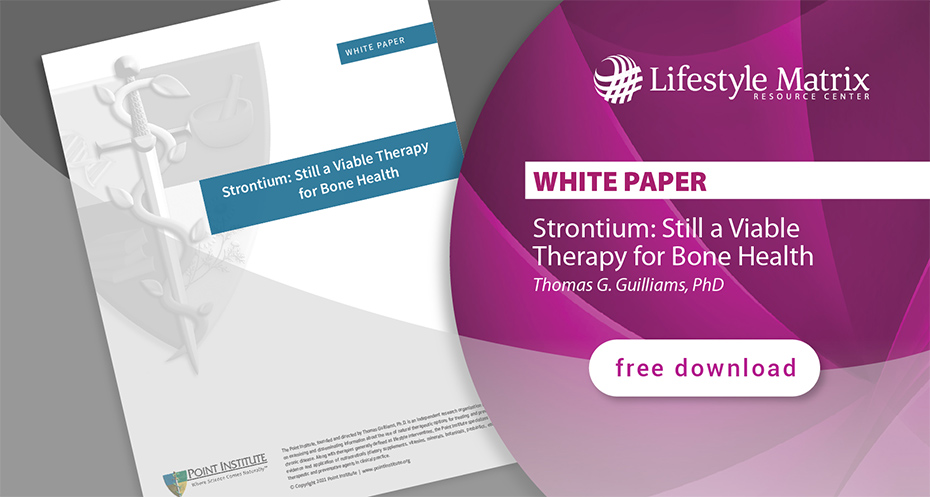Strontium (Sr) is an alkali earth metal, with characteristics very similar to that of calcium; though having an atomic weight nearly double that of calcium. First discovered in the 18th century, this trace element is found in ground water, ocean water and in various foods such as leafy green vegetables and some seafood. The ability for Sr to naturally accumulate in the bones of animals after being fed small doses was first published in 1870.1,2 However, it wasn’t until the 1950s that human studies were first published; most notably McCaslin and Jane’s case series of subjects given strontium lactate (6.4 grams/day in divided doses- delivering 1.7 grams/day of Sr) published in the Mayo Clinic Proceedings in 1959.3 They concluded their study by saying “A study has been made of the case records of 32 patients treated for osteoporosis with strontium lactate, or strontium lactate with hormones, and then traced for various periods with repeated physical and roentgenographic examinations.
Marked subjective improvement was experienced by 84 per cent of the patients. Although the mechanism of action of strontium lactate in the treatment of osteoporosis remains to be elucidated, the therapeutic value of the drug appears to be established.” However, it would be another four decades before the use of strontium would become a common therapy for osteoporosis, with the approval of the patentable compound Sr Ranelate (as Osseor® / Protelos® / Protos®) in Europe and elsewhere.† Sr Ranelate is a compound formed from two molecules of strontium with ranelic acid, which delivers 340 mg of elemental strontium in every gram. The approval of Sr Ranelate was based upon a series of highly successful Phase 2 and Phase 3 clinical trials published between 2002-2005; along with a host of animal studies and mechanism studies published in the preceding years.4,5,6,7
These studies provided strong evidence for Sr ranelate’s anti-fracture benefits, which was associated with Sr accumulation in bone and increased bone mineral density (BMD).8,9 Subsequently, Sr Ranelate was considered a first-line therapy for anti-fracture therapy in post-menopausal women in many of the countries where it was approved.
The use of oral strontium compounds to improve bone strength and reduce fracture risk has proven to be quite successful over the past few decades, established using experiments in both humans and animals. These clinical results align with a host of basic scientific research showing numerous mechanisms by which strontium modulates bone architecture and metabolism. Nonetheless, the use of oral strontium compounds for improving bone strength is controversial amongst some clinicians for a variety of reasons.
References
- Okumura R, Takeda K. Maintenance of intestinal homeostasis by mucosal barriers. Inflamm Regen. 2018 Apr 2;38:5. doi: 10.1186/s41232-018-0063-z. PMID: 29619131; PMCID: PMC5879757.
- Marx D, Rahimnejad Yazdi A, Papini M, Towler M. A review of the latest insights into the mechanism of action of strontium in bone. Bone Rep. 2020 Apr 24;12:100273
- McCaslin F Jr, Janes J. The effect of strontium lactate in the treatment of osteoporosis. Mayo Clin Proc 1959;34:329-34.
- Reginster JY, Deroisy R, Dougados M, Jupsin I, Colette J, Roux C. Prevention of early postmenopausal bone loss by strontium ranelate: the randomized, two-year, double-masked, dose-ranging, placebo-controlled PREVOS trial. Osteoporos Int. 2002 Dec;13(12):925-31.
- Meunier PJ, Slosman DO, Delmas PD, Sebert JL, Brandi ML, Albanese C, Lorenc R, Pors-Nielsen S, De Vernejoul MC, Roces A, Reginster JY. Strontium ranelate: dose-dependent effects in established postmenopausal vertebral osteoporosis--a 2-year randomized placebo controlled trial. J Clin Endocrinol Metab. 2002 May;87(5):2060-6.
- Reginster JY, Seeman E, De Vernejoul MC, Adami S, Compston J, Phenekos C, Devogelaer JP, Curiel MD, Sawicki A, Goemaere S, Sorensen OH, Felsenberg D, Meunier PJ. Strontium ranelate reduces the risk of nonvertebral fractures in postmenopausal women with osteoporosis: Treatment of Peripheral Osteoporosis (TROPOS) study. J Clin Endocrinol Metab. 2005 May;90(5):2816- 22.
- Reginster JY, Deroisy R, Neuprez A, Hiligsmann M, Zegels B, Bruyere O. Strontium ranelate: new data on fracture prevention and mechanisms of action. Curr Osteoporos Rep. 2009 Sep;7(3):96-102.
- Blake GM, Fogelman I. Strontium ranelate: a novel treatment for postmenopausal osteoporosis: a review of safety and efficacy. Clin Interv Aging. 2006;1(4):367-75.
- Blake GM, Fogelman I. Strontium ranelate: a novel treatment for postmenopausal osteoporosis: a review of safety and efficacy. Clin Interv Aging. 2006;1(4):367-75.
This blog is an excerpt taken from a whitepaper recently written by Dr. Guilliams discussing the data, for and against, the use of oral strontium therapies for bone-building purposes in subjects that are at-risk for fractures; including therapeutic conundrums that arise when successfully using strontium.

Thomas G. Guilliams, PhD
Thomas G. Guilliams, PhD (Tom) earned his doctorate in molecular immunology from the Medical College of Wisconsin in Milwaukee. For the past two decades, he has spent his time investigating the mechanisms and actions of lifestyle and nutrient-based therapies, and is an expert in the therapeutic uses of dietary supplements. Tom serves as an adjunct assistant professor at the University of Wisconsin School of Pharmacy and was the VP of Science for Ortho Molecular Products for 24 years (he now serves them as a consultant). Since 2014 he has been writing a series of teaching manuals (Road Maps) that outline and evaluate the evidence for the principles and protocols that are fundamental to the functional and integrative medical community. He is the founder and director of the Point Institute, an independent research and publishing organization that facilitates the distribution of his many publications. A frequent guest-speaker, Dr. Guilliams provides training to a variety of health care disciplines in the use of lifestyle and natural medicines. He lives in the woods outside of Stevens Point, Wisconsin with his wife and children.

.jpg?sfvrsn=acc7eafb_0)


